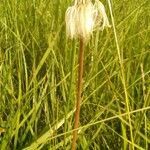Herbs 10-60 cm tall, perennial, rosulate, entirely glabrous. Rootstock creeping, ca. 1.5 cm in diam., usually branched. Caudex with or without scarious leaf sheath residues. Stems solitary or few, ascending to erect, unbranched or rarely sparsely branched. Rosette leaves lanceolate or narrowly elliptic to linear, 7-20 × 0.2-1.5 cm, often somewhat fleshy, base attenuate, apex acute to acuminate. Stem leaves few, smaller than rosette leaves, narrowly lanceolate. Capitulum solitary, rarely 2 or 3 per stem and distant. Involucre cylindric, usually 1.5-1.8 × 0.5-0.8 cm at anthesis, to 2.5-3 × 1-1.3(-1.5) cm in fruit. Phyllaries abaxially glabrous, apex acute to subobtuse; outermost phyllaries ovate to triangular-ovate. Florets yellow, slightly longer than involucre. Achene yellowish, cylindric, 7-9 mm, with smooth elevated ribs, glabrous. Pappus dirty white, 1.5-1.8 cm. Fl. and fr. Jun-Sep. 2n = 14.
More
A herb. It grows 10-60 cm tall. It keeps growing from year to year. The leaves are in a ring. The rootstock is 1.5 cm across and creeping. There is one or a few stems that are only occasionally branched. The leaves at the base are narrowly oval and 7-20 cm long by 1-2 cm wide. There are only a few leaves on the stem and they are small. The flowers are yellow.
It is a temperate plant. It grows in wet, slightly salty meadows and riverbanks between 900-1,700 m above sea level in western China.

